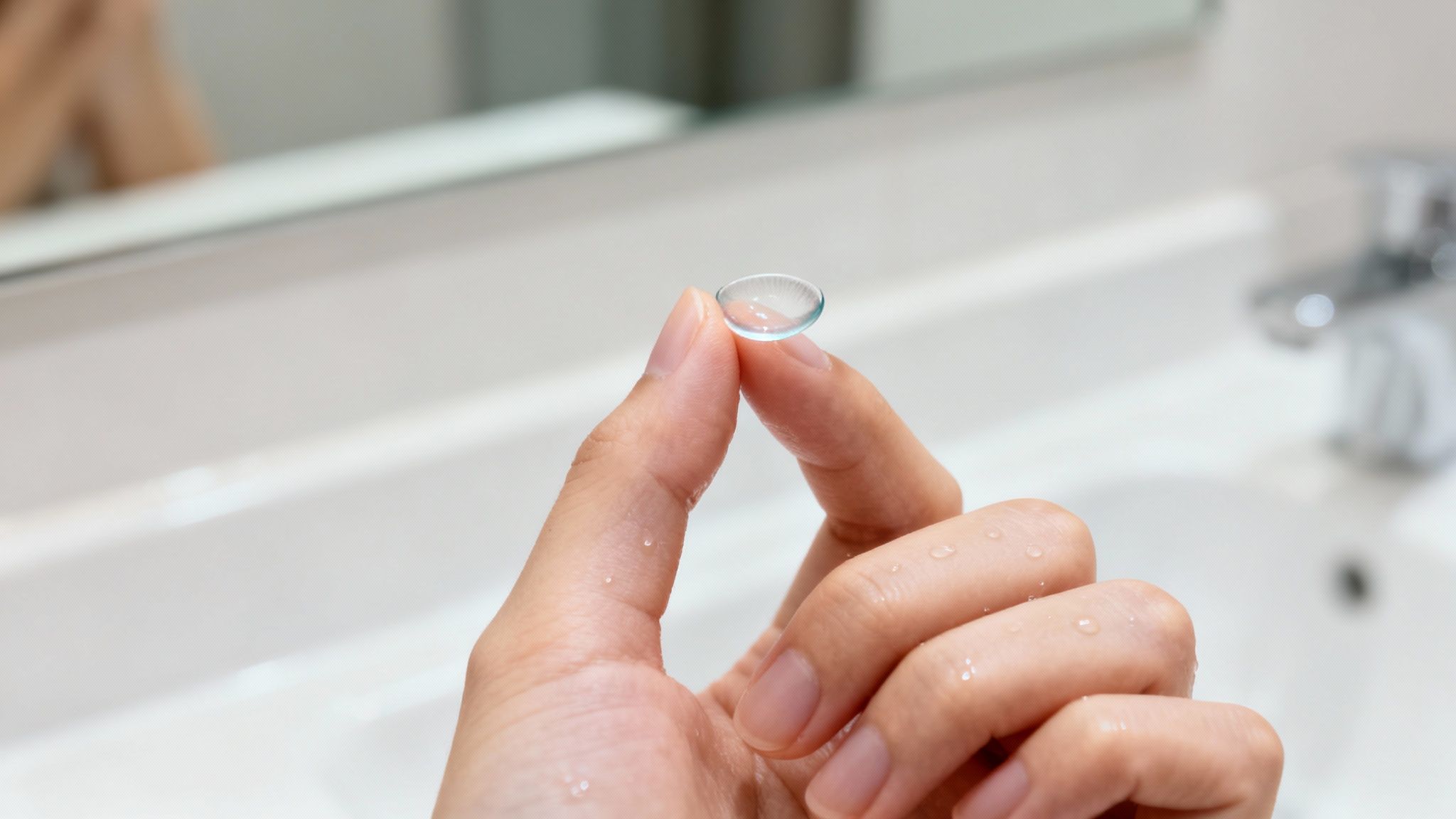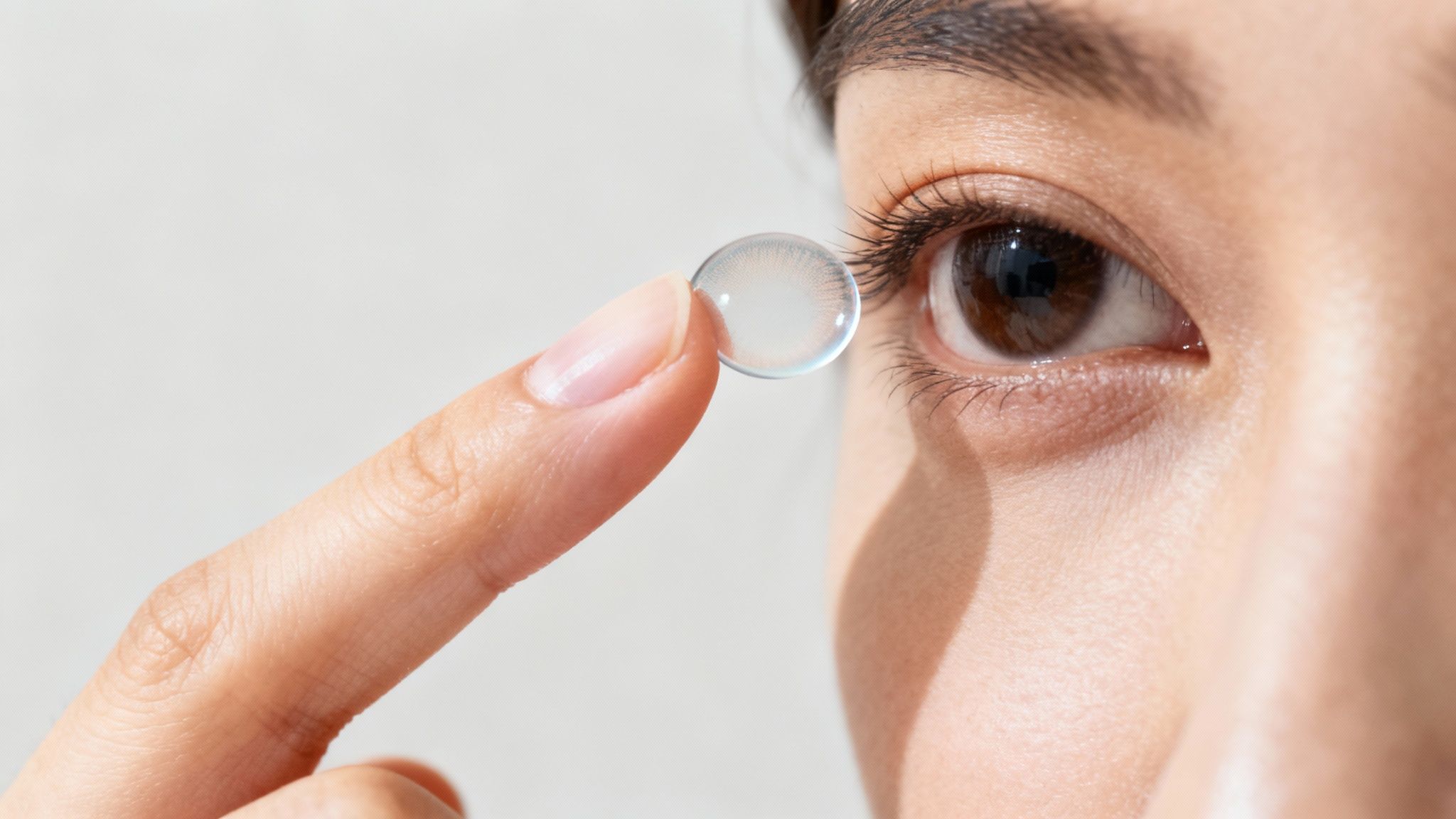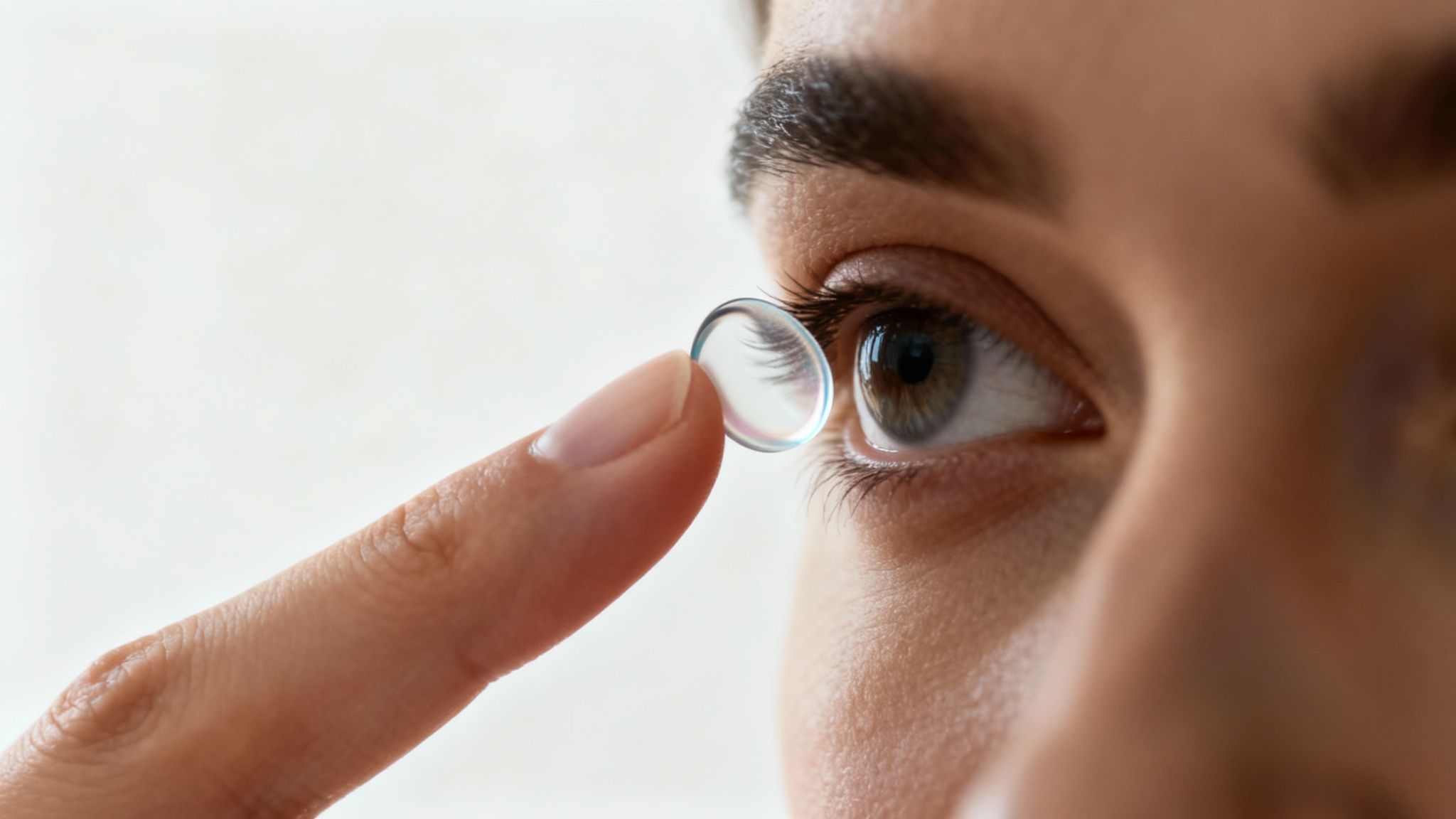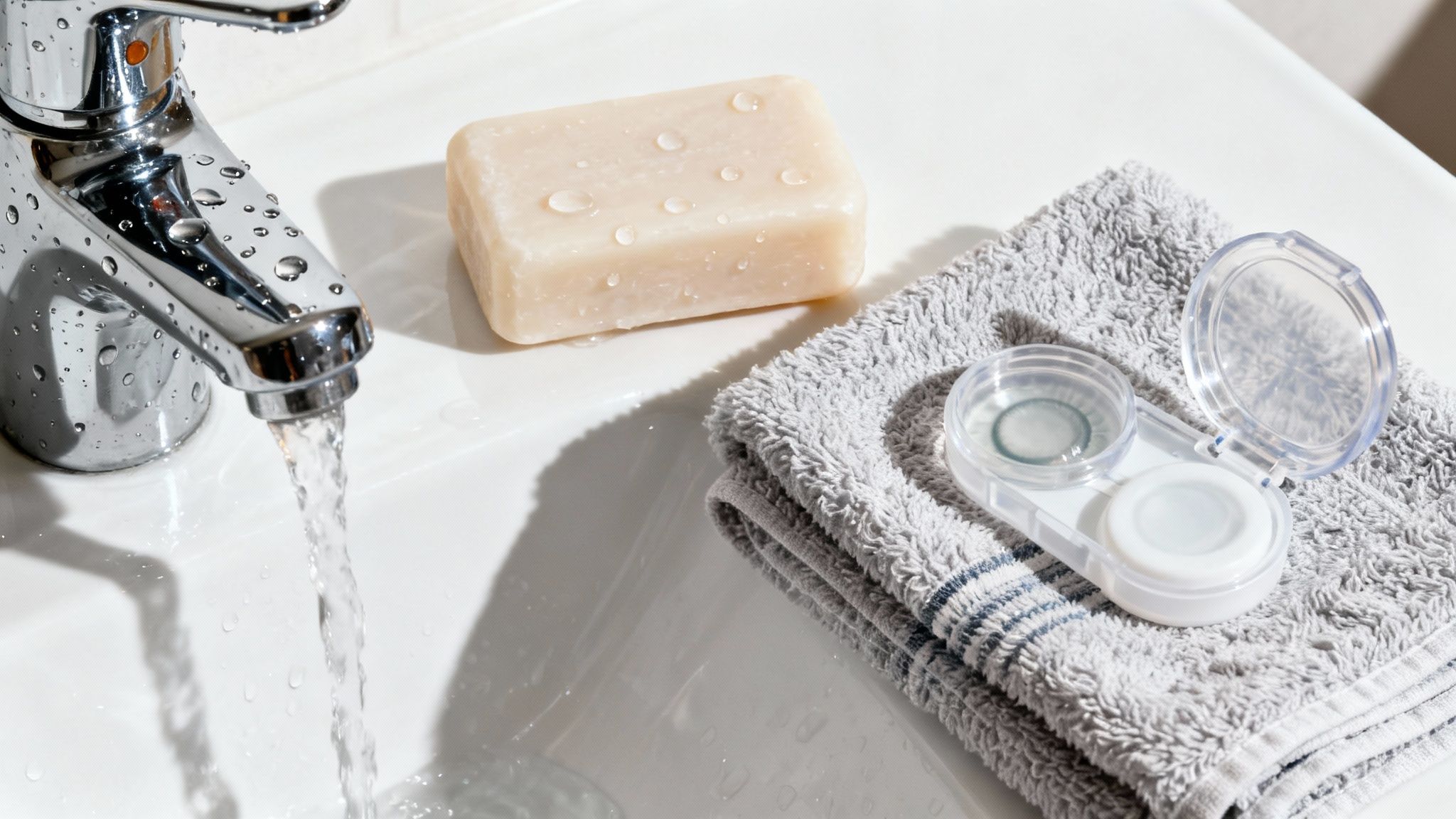Taking out your contact lenses doesn't have to be a daily wrestling match, especially for new wearers right here in Glendale Heights. I get it—the thought of pinching a tiny lens off your eye can be pretty intimidating at first. My goal is to help you turn that uncertainty into confidence, making removal a quick, painless part of your nightly routine.
Your Guide to Stress-Free Contact Lens Removal
For many of our first-time contact lens patients at iDoctor, figuring out how to get contacts out is the biggest hurdle. The good news? With a little practice and the right technique, it becomes as natural as brushing your teeth.
Think of this as the essential lesson that helps you skip all the common frustrations, like red, irritated eyes or a lens that just won't budge. Proper removal is just as crucial as putting them in. If you need a refresher on that, our guide on how to put contacts in your eye has you covered.
The Foundation for Easy Removal
Before you even get near your eye, setting the stage properly is the key to a smooth experience. Success really comes down to three things: hygiene, preparation, and technique.
- Start with Clean Hands: This is non-negotiable. Always wash your hands thoroughly with soap and water, then dry them completely with a lint-free towel. It’s the single most important thing you can do to prevent nasty eye infections.
- Create Your Space: Find a well-lit area with a clean counter and a mirror. Trying to do this in a dimly lit room or when you're in a hurry is a recipe for frustration.
- Relax: Seriously, take a deep breath. If you're tense, your eye muscles will be too, which makes it harder to keep your lids open and cooperative.
This simple infographic breaks down the prep work perfectly.
As you can see, mastering these first few actions—clean hands, a prepared space, and knowing your removal method—is half the battle. While there are tools out there to help, most people just use their fingers. The global market for contact lens removers is only valued at around $35 million, which shows that the vast majority of wearers rely on mastering their own technique. You can discover more insights about the contact lens accessory market to see what's available.
The Go-To Technique: The Pinch Method
The "pinch method" is the classic removal technique for a reason—it’s effective, quick, and the one we teach most of our patients right here at our Glendale Heights boutique. While it might sound a little intimidating at first, the motion is surprisingly simple once you get the hang of it. This isn't about just grabbing the lens; it's a gentle, controlled movement designed to protect your eye.
The trick is to avoid pinching the lens directly over your pupil. Instead, the goal is to first break the gentle suction that holds it in place. By using the soft pads of your fingertips—and never your nails—you’ll get a clean, easy release every single time.
Mastering the Motion
Ready to give it a try? Start by looking up and using the middle finger of your non-dominant hand to pull down your lower eyelid. This little move creates a stable surface and helps stop you from blinking.
Next, bring your dominant index finger to the bottom edge of the lens and gently slide it down onto the white part of your eye (the sclera). This is the most crucial part of the process. Moving the lens off the cornea breaks the surface tension, making it much easier to handle.
From there, bring your thumb toward your index finger and use the pads to softly pinch the lens. It should fold up easily and come right out.
Insider Tip: Make sure your fingertips are completely dry before you start. Any moisture will make the lens stick to your finger, making it nearly impossible to get a good grip.
For a quick reference, here’s a breakdown of what to do—and what to avoid—when using this technique.
Pinch Method Do's and Don'ts
| Do | Don't |
|---|---|
| Wash and dry your hands thoroughly. | Use your fingernails to grab the lens. |
| Look up while pulling your lower lid down. | Pinch the lens while it's over your cornea. |
| Slide the lens to the white of your eye first. | Pinch too hard; a gentle touch is all you need. |
| Use rewetting drops if your eye feels dry. | Panic if the lens folds; just blink and restart. |
This table should help you build the right habits from the start, making the process smooth and comfortable.
Common Hiccups and Quick Fixes
Even with the best technique, things don't always go perfectly, and that’s completely normal. If the lens folds in your eye before you can grab it, just blink a few times to let it settle back into place and then try again. If it sticks stubbornly to your finger after removal, you’re probably pinching too hard. A lighter touch is all it takes.
Here are a couple of other common issues:
- Lens Won't Budge? Your eye is likely too dry. A few rewetting drops (the kind approved for contacts) will do the trick. Wait about 30 seconds for the moisture to get behind the lens, then try again.
- Pinch Feels Awkward? Take a look at your hand position. Your fingers should form a wide "V" shape as they approach your eye, not a sharp, pointy pincer.
Perfecting this method makes daily removal second nature. It becomes just another part of your routine, like the daily care involved with different lens types. For those who wear daily disposables, you can read more about their convenience in our guide to the benefits of disposable contact lenses.
Whether you're a student at Glenbard West High School or just driving down Bloomingdale Road, a confident removal technique makes life with contacts so much simpler.
An Alternative Approach: The Rolling Method
If the pinch method feels a bit clumsy or just isn't clicking for you, you're not alone. Many people, especially those with longer nails or sensitive eyes, find it a little too direct. There’s another great option: the "rolling method." It’s a fantastic, gentle alternative that skips the pinching part entirely.
Instead of a direct pinch, this technique uses a subtle sliding motion to break the lens's seal on your eye. You simply use your index finger to guide the lens down toward the white of your eye. Once it moves off the cornea, it naturally buckles and folds, making it incredibly easy to sweep out without irritation.
Nailing the Roll
A light, gentle touch is the secret here. Just like with the pinch method, start by using one hand to hold your upper and lower eyelids open to prevent blinking.
Now, here’s the key part: look inward, toward your nose. This shifts your lens and exposes the outer white part of your eye (the sclera).
- Gently place the pad of your index finger on the edge of the contact lens.
- Slowly slide the lens downward and toward the outer corner of your eye.
- As the lens moves onto the white, it will wrinkle up on its own, breaking the suction.
- From there, you can easily sweep it out.
This gentle approach is a game-changer for anyone hesitant about touching their cornea directly. By working on the less sensitive white part of the eye, you can build confidence and turn removal into a stress-free part of your day.
This method is great for all types of soft lenses, but it’s especially handy for daily disposables. It's no surprise that dailies are so popular—they accounted for over 33.5% of the global market revenue in 2023. People love them because they simplify the entire routine.
Since you just toss them at the end of the day, there's no cleaning involved, which makes a quick, easy removal technique like this even more appealing.
If you're curious about which type of lens is right for you, understanding the differences is a great first step. You can learn more by comparing daily disposable vs. monthly contact lenses in our Glendale Heights guide.
Troubleshooting Common Contact Lens Removal Headaches
Even if you’ve got your removal technique down to a science, some days a lens just won't cooperate. We’ve all been there—that brief flash of panic when a contact feels glued to your eye. But don't worry, it's a super common experience and almost always an easy fix.
Most of the time, the problem boils down to one simple thing: dryness. When a soft lens dries out, it can create a suction-cup effect on your eye, making it tough to move or pinch. This frustration is a big deal; in fact, the dropout rate for contact lens wearers still hovers above 10%, and difficulty handling the lenses is a major reason people give up.
When a Lens Feels Stuck or Dry
If your lens won’t budge, your first instinct might be to pinch harder or dig at it. Fight that urge! Too much force can irritate your eye or, worse, cause a painful corneal scratch. The real secret isn't more force—it's more moisture.
The best tool for the job is a bottle of rewetting drops made specifically for contact lenses.
- Start by putting two or three drops into the eye with the stuck lens.
- Close your eye and blink gently a few times. This helps the solution get underneath the lens and break that suction.
- Give it at least 30 seconds to work its magic before you try taking the lens out again.
Nine times out of ten, this is all it takes to rehydrate the lens, allowing it to slide down for an easy removal. If you find yourself dealing with this often, it might be worth looking into the best contact lenses for dry eyes.
The "Oh No, It's Lost!" Moment
It’s a classic fear: the lens has vanished somewhere behind your eyeball. Let me put your mind at ease right now—that's physically impossible. A thin membrane called the conjunctiva connects your eyelid to your eyeball, creating a barrier that nothing can get behind. Phew.
So where did it go? Usually, it has just folded over on itself or slid way up under your upper eyelid.
To coax it out, try closing your eye and gently massaging your eyelid, moving downwards toward your nose. If that doesn’t work, look in a mirror, tilt your head down, and carefully lift your upper eyelid. You can usually see the folded lens hiding in there. From there, you can gently slide it back down. For a more detailed walkthrough, check out our guide on what to do when you have a contact lens stuck in your eye.
Of course, if you’re ever truly stuck or feel any lasting irritation, don't just "wait and see." It's always best to see your optometrist. Our team at iDoctor is always here to help with professional advice and your contact lenses in Glendale Heights.
Essential Hygiene and Aftercare Habits
Taking your contacts out is just the beginning. The real key to keeping your eyes healthy and comfortable for the long haul comes down to the small, consistent habits you practice every single day.
First things first, and this is non-negotiable: always wash your hands with soap and water before you even think about touching your eyes or your lenses. Once they're clean, dry them with a lint-free towel. This one simple act is your best defense against transferring nasty bacteria or tiny bits of debris that can cause a world of irritation—or worse, an infection.
What to Do After the Lenses Are Out
Your next move all depends on what kind of lenses you wear.
- Daily Disposables: This is the easy part. Just toss them in the trash. No cleaning, no fuss. Whatever you do, don't try to get a second day out of them.
- Monthlies or Bi-Weeklies: These require a bit more attention. Once a lens is out, place it in the palm of your clean hand. Add a few drops of fresh contact solution and gently rub the lens with your fingertip to dislodge any buildup. Give it another quick rinse with more solution before popping it into a clean case filled with new solution.
I can't stress this enough: Never top off the old solution in your case. It loses its disinfecting power overnight and basically becomes a swamp for germs to thrive in. Always dump the old stuff and start fresh.
Sticking to these rules is crucial for your eye health. If you want to dive deeper, we've put together some great expert tips on how to prevent common contact lens infections.
One last thing—be sure to replace your lens case every three months, even if it looks clean. And don't forget to give your eyes a rest! Swapping out your contacts for a stylish pair of designer eyeglasses in Glendale Heights now and then is a fantastic way to keep your eyes in great shape.
Your Glendale Heights Contact Lens FAQs
At iDoctor, we've heard every contact lens question in the book. It's completely normal to have a few worries when you're starting out, so we wanted to tackle some common concerns we hear from our Glendale Heights and Chicagoland neighbors.
What should I do if my contact lens feels stuck?
First, don't panic! A lens can't get lost behind your eye. If it feels stuck, it's usually just dry. Add a few approved rewetting drops, blink gently, wait a minute, and then try removing it again. If you still have trouble, it's time to call the best optometrist in Glendale Heights—us! We're here to help.
Where can I get properly fitted for contact lenses?
Right here at iDoctor in Glendale Heights! A proper fitting is crucial for comfort and eye health. We provide detailed eye exams in Glendale Heights that include precise measurements and high-resolution imaging to find the perfect lenses for your unique eyes and lifestyle.
Do you accept my vision insurance?
Yes! We believe high-end eye care should be accessible. iDoctor accepts all major vision insurance plans. You can enjoy our detailed 30-minute eye exams and browse our curated collection of luxury eyewear without worrying about coverage.
Ready to experience exceptional eye care and find the perfect eyewear? At iDoctor, we combine clinical precision with high-end fashion to give you the best of both worlds in Glendale Heights. Visit us at https://idoctoril.com to book your appointment today.







